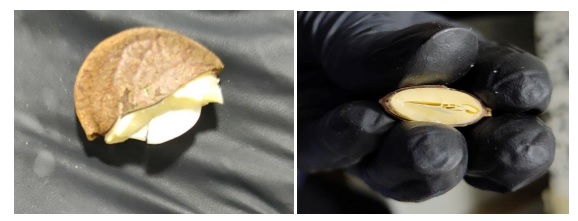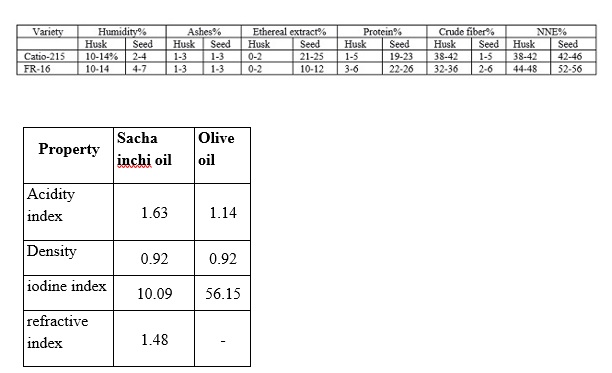Autores
Sarria-villa, R. (UNIVERSIDAD DEL CAUCA) ; Orozco, M. (UNIVERSIDAD NACIONAL ABIERTA Y A DISTANCIA) ; Gallo, J.A. (UNIVERSIDAD DEL CAUCA)
Resumo
Catio-215 and FR-16 varieties of sacha inchi from Tambo Cauca-Colombia were
analyzed. Husk and seed samples were analyzed. Chemical analyzes carried out on
the samples were: humidity, ashes, ethereal extract, protein, crude fiber, and
non-nitrogenous extract (NNE). Results indicate a range of humidity of 10-14%; 2-
4%, 10-14%; 4-7%, ashes of 1-3%; 1-3%, 1-3%; 1-3%, ethereal extract between 0-2%;
21-25%, 0-2%; 10-12%, protein of 1-5%; 19-23%, 3-6%; 22-26%, crude fiber of 38-
42%; 1-5%, 32-36%; 2-6%, non-nitrogenous extract 38-42%; 42-46%, 44-48%; 52.56% to
husk and seed of catio-215 and FR-16 varieties respectively. The results indicate
an interest in the production and extraction of vegetable oil.
Palavras chaves
Sacha inchi; Proximal analysis; Vegetable oil
Introdução
Sacha inchi (Plukenetia Volubilis), is a wild oil-bearing plant, whose seeds
(lenticular in appearance, laterally compressed, and brown with irregular darker
spots) have a high protein value and a high content of polyunsaturated fatty
acids compared to all oilseeds used in the world (Gómez, 2005). The Sacha inchi
seed is the part with the highest value because derivatives are obtained in
sectors such as food since oil is obtained by pressing; pharmaceuticals, for the
manufacture of sacha inchi capsules, and in cosmetics, in the manufacture of
anti-wrinkle cream (Sathe et al., 2002; IAP, 2009). The analysis of the chemical
composition of the by-products gives indications that they are potential
nutritional sources, for which, as an alternative, their use as fertilizer, and
food supplements for animal or human food consumption has been studied (Sathe et
al., 2002). According to the United Nations report in 2021, “Its cultivation in
the Colombian countryside is relatively new. In June 2021, the government agency
ProColombia reported “The Sacha inchi is cultivated by more than 1,100 farmers
located in 22 departments of Colombian territory, among which are: Caquetá,
Córdoba, Arauca, Antioquia, the Coffee Region, Huila, and Tolima. The growth of
the Sacha inchi industry in the Cauca department and its potential use as a
substitute for illicit crops would generate economic development in the region,
either with the transformation of the raw material into oil, food supplements,
and/or cosmetics. These processes are supported and/or accompanied by the
academy which provides technical knowledge that can provide better conditions
for the production of plants, the classification of the varieties obtained, the
chemical composition of each of the products, and quality analysis of the
products obtained.
Material e métodos
Methodology
Sacha inchi seeds of the cross varieties (catio-215 and FR-16) underwent a
proximal analysis, which consisted of the determination of moisture, ashes,
ether extract, fiber, and crude protein. The analysis was performed in
triplicate (Benítez et al., 2015).
Samples
Given the granular consistency of the sacha inchi seed, the sample was chosen
using the quartering method (3 repetitions) for each of the parts (husk, and
seed). With the samples already separated, the conditioning was carried out,
which consisted of crushing and subsequent screening (1mm) of the sample to
homogenize it for subsequent analysis.
Reagents
Hydrochloric Acid 37% pure pharma grade PanReac, Sulfuric Acid 96% for analysis,
ISO PanReac, Sodium hydroxide anhydrous pellets for analysis carlo erba, Boric
Acid for analysis PanReac, Kjeldhal Catalyst with Selenium powder Chemí, Mixed
Indicator 5 Tashiro Chemí, Ethanol absolute for analysis, ACS ISO.
Resultado e discussão
Sacha inchi is an oily plant, from which its star-shaped fruit is taken and the
seeds are extracted, these are of commercial interest because they have a
content of unsaturated fatty acids suitable for human consumption, and this has
led to the wide development and expectation of the crop in the Cauca department.
Samples of seeds and husk of the catio-215 and FR-16 varieties were analyzed,
which allowed the respective comparisons to be made.
In Colombia, sacha inchi (Plukenetia volubilis) has a wide potential for agro-
industrial development; However, some varieties such as Catio-215 and FR-16
cultivated in the department of Cauca, in the municipalities of Tambo and
Timbio, the real value of the nut and its by-products for use in nutrition is
not known. both animal and human. The objective of the study was to determine
the nutritional composition of the seeds and the hull of two varieties grown in
the department of Cauca, as well as to determine the content of acidity index,
relative density, iodine index, peroxide index and saponification index of the
sacha inchi oil Statistically significant differences (p > 0.05) were found for
the nutritional components evaluated in seed and husk of both varieties of sacha
inchi. The catio-215 seeds presented a higher percentage of protein and fat in
relation to FR-16, 22.78% and 21.85% respectively, compared to 0.71% fat and
4.87% protein in the FR -16 variety (Table 1). On the contrary, the husk of the
FR-16 variety is the fat that presents the highest percentage of and protein in
relation to the catio-215 variety, which allows us to see a relationship between
the analyzed materials, a higher percentage of fat and protein in the nut, lower
percentage of both in the shell. Sacha inchi nut protein is a rich source of
memories: lysine and tyrosine, lysine being an amino acid that acts as a
precursor to carnitine, which is necessary for fat metabolism and energy
production. The sacha inchi protein of both species has the potential to be used
in human nutrition due to its high nutritional value, the presence of
antinutrients must be verified.
Table 1. Chemical analysis of catio-215 and FR-16 sacha inchi varieties
Figure 1. Sacha inchi seed (FR-16) from Tambo-Cauca-Colombia.
Table 2 shows the acid number of this oil is 1.63 mg KOH/g. According to
(FAO/WHO, 2015) it should not be greater than 4 mgNaOH/g for cold-pressed
vegetable oils, this is due to the fact that it does not present refining,
values very similar to those of olive oil, which according to (Paucar-Menacho et
al, 2015) has a value of 1.14 mgNaOH/g. The density of 0.92 shows that this oil
is light due to the amount of unsaturated fatty acids present (Gutiérrez et al.,
2011). The iodine index relates the degree of saturation, a result of 10.09
compared to 56.15 for olive oil, this could be due to inadequate storage of the
oil once it was extracted by pressing.
Table 2. Physicochemical characteristics of Sasha inchi oil


Conclusões
The fruit of the sacha inchi presents high amounts of polyunsaturated fatty acids,
however, the percentage differs according to the variety and the factors that can
affect the development of the crop, there is a great difference between catio-215
and FR-16 varieties. It is observed how characteristics such as humidity or the
percentage of ash are key to the quality and quantity of polyunsaturated fatty
acids that it can provide, remembering that this is the greatest interest of the
commercial plant, and that according to its quality it can not only be used in the
food industry but also in cosmetics and pharmaceuticals.
Agradecimentos
The authors thank to groups GIQA, QPN, VRI-Unicauca, Proy ID 5491 (conv.
interacción social), Department of Chemistry-Unicauca (501100005682) for their
collaboration in the development of this research. Cooperativa Sacha Tambo.
Referências
J; GÓMEZ. Monografía y cultivo de sacha inchi (Plukenetia volubilis L.). Bogotá D. C.: Produmedios. 2005.
S; SATHE et al. Isolation, Purification, and Biochemical Characterization of a Novel Water Soluble Protein from Inca Peanut (Plukenetia volubilis L.). J. Agric. Food Chem. 50, 4906. 2002.
Instituto de Investigaciones de la Amazonía Peruana (IAP). Estudio de viabilidad económica del cultivo de Plukenetia volubilis Linneo, sacha inchi, en el Departamento de San Martín, Iquitos. p. 66. 2009.
I; MONDRAGÓN. Estudio farmacognóstico y bromatológico de los residuos industriales de la extracción del aceite de Plukenetia volubilis L. (Sacha inchi). Universidad Nacional Mayor de San Marcos, Perú. p. 127. 2009.
R; BENÍTEZ B, C; CORONEL, Z; HURTADO, J; MARTÍN. Composición química de la cáscara de sacha inchi (Plukenetia volubilis) y alternativas para su aprovechamiento como subproducto agroindustrial. El Hombre y la Máquina, núm. 46, enero-junio, pp. 28-32 Universidad Autónoma de Occidente Cali, Colombia. 2015.
S.K; SATHE, B.R; HAMAKER, K.W.C; SZE-TAO, & M; VENKATACHALAM. Isolation, purification, and biochemical characterization of a novel water soluble protein from Inca peanut (Plukenetia volubilis L.). Journal of Agricultural and Food Chemistry, 50(17), 4906–4908. 2002. https://doi.org/10.1021/jf020126a
P; MOSER, O; FREIS, V; GILLON, L; DANOUX. Extract of a Plant Belonging to the Genus Plukenetia Volubilis and Its Cosmetic Use. United States Patent Appl. Publ. within the TVPP US20050666769. 26 Oct 2005.
Z.Q; CAI. Shade delayed flowering and decreased photosynthesis, growth and yield of Sacha Inchi (Plukenetia volubilis) plants. Industrial Crops and Products, 34(1), 1235–1237. 2011. https://doi.org/10.1016/j.indcrop.2011.03.021
M; OCELÁK, P.H; ČEPKOVÁ, I; VIEHMANNOVÁ, Z; DVOŘÁKOVÁ, D.C; HUANSI, & B; LOJKA. Genetic diversity of Plukenetia volubilis L. assessed by ISSR markers. Scientia Agriculturae Bohemica, 46(4), 145–153. 2015. https://doi.org/10.1515/sab-2015-0029
L.M; PAUCAR-MENACHO et al. Estudio comparativo de las características físico-químicas del aceite de sacha inchi (Plukenetia volubilis l.), aceite de oliva (Olea europaea) y aceite crudo de pescado. Scientia Agropecuaria, Trujillo , v. 6, n. 4, p. 279-290, oct. 2015. http://dx.doi.org/10.17268/sci.agropecu.2015.04.05.
L.F; GUTIERREZ et al. Chemical composition of Sacha Inchi (Plukenetia volubilis L.) seeds and characteristics of their lipid fraction. Grasas y aceites, 62 (1), enero-marzo, 76-83, 2011, ISSN: 0017-3495 doi: 10.3989/gya044510
FAO/WHO. (FOOD STANDARDS PROGRAMME CODEX COMMITTEE ON FATS AND OILS). Virtual, 18 - 26 October 2021.
Reportaje escrito por Lucía Benavente para Noticias ONU https://news.un.org/es/story/2021/10/1498782
https://procolombia.co/noticias/el-aceite-colombiano-de-sacha-inchi-pisa-fuerte-en-el-mercado-internacional
















